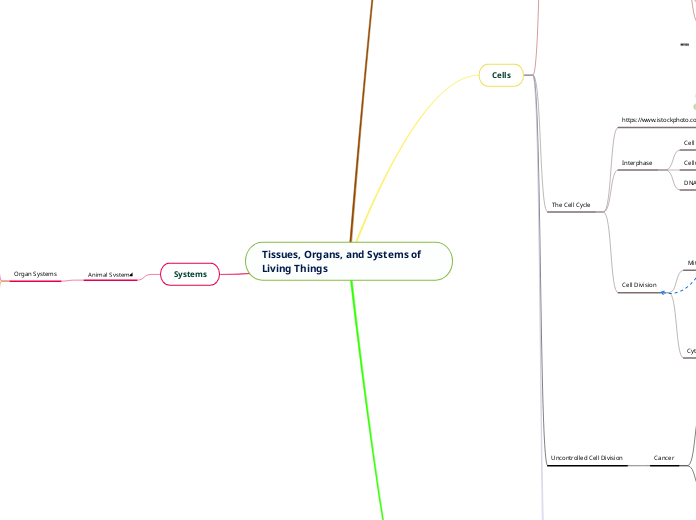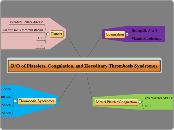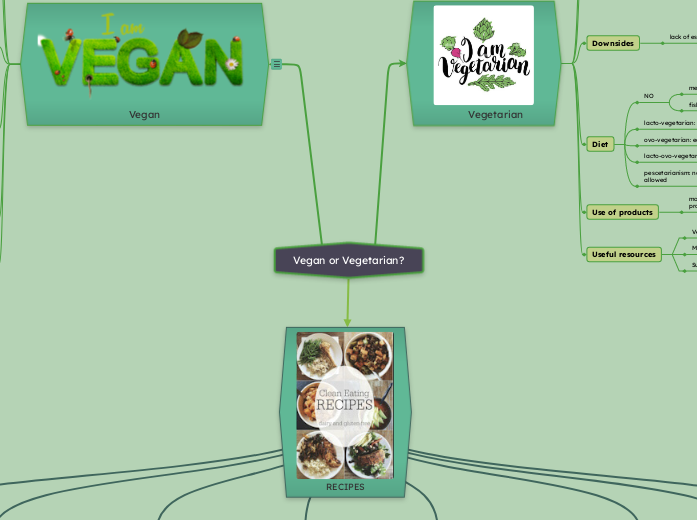Tissues, Organs, and Systems of Living Things
Systems
Animal Systems
Organ Systems
The Nervous System
Neurons
Send information around the body using
electrical signals
Peripheral Nervous System
Part of the nervous system consisting of the
nerves that connect the body to the nervous system
Central Nervous System
Part of the nervous system consisting
of the brain and the spinal cord
Respiratory System
Lung
Holds oxygen to enter the bloodstream
through diffusion
Bronchus
Deliver air into the lungs
Trachea
Separates into two different branches
called bronchi
Pharynx
Tube that air flows down to reach the trachea
Mouth
Nasal Cavity
Allows air to enter the body
The Circulatory System
Blood Vessels
Capilleries
Thin-walled blood vessel that enable the
exchange of gas, nutrients and waste
Veins
Blood vessel that returns blood to the heart
Arteries
Thick-walled blood vessel that
carries blood away from the heart
Heart
Heart Attack
Coronary arteries become blocked, preventing
flow of blood and oxygen
Contracts to pump blood throughout the body
Blood
Types
Plasma
Protein-rich liquid which carries
blood cells
Platelet
Assist in blood clotting
White
Recognize and destroy harmful
bacteria and viruses
Red
Contain hemoglobin to transport
oxygen throughout the body
Connective tissue that circulate
throughout the body
Organs
Tissue
Nerve Tissue
Specialized tissue that conducts electrical
signals from one part of the body to another
Muscle Tissue
Group of specialized tissues
containing proteins that can contract
and enable movement
Connective Tissue
Specialized tissue that provides
support and protection
Epithelial Tissue
Tightly packed cells that cover
body surfaces and internal organs
Microscope
Parts of a Microscope
Base
Support of the microscope
Fine Focus
Moves stage in small increments
Coarse Focus
Moves the stage to general focus
Arm
Connects base to nosepiece and eyepiece
Ocular Lens
Magnfication
Ocular Lens Magnification x Objective Lens Magnification
Magnifies the image created by the objective lens
Illuminator
Provides light through the stage onto the slides
Diaphragm
Controls the amount of light passing
through the slide
Stage
Where the slides is placed
Stage Clips
Hold the slides in place on the stage
Objective Lens
Different lenses with different levels of magnification
serve to magnify the object
Nosepiece
Holds the objective lenses
Body Tube
Holds the ocular lens
https://smartschoolsystems.com/parts-of-a-microscope-2/
Cells
Cellular Differentiation
The process of creating a specialized cell
to perform specific functions
Stem Cells
Tissue Stem Cells
Only able to differentiate into
certain types of cells
Embryonic Stem Cell
Can differentiate into any
kind of cell
An undifferentiated cell that can
divide into specialized cells
Uncontrolled Cell Division
Cancer
Treatments
Biphotonics
Detects and treats cancer through use
of beams of light
Radiation
Damages and prevents cell division
using ionizing radiation
Chemotherapy
Drug treatment prevents cancer cells
from dividing
Surgery
Physically removing cancerous tissue
Causes
Mutation
Carcinogen
Environmental factors that cause mutations
Random changes occurring in DNA
The Cell Cycle
Cell Division
Cytokinesis
Plate develops new cell wall
Cell membrane is pinched off in center
Mitosis
Telophase
New nuclear membrane forms around each group
of daughter chromosomes
Anaphase
Centromere splits and sister chromatids separate
to opposite sides of the cell, becoming daughter chromosomes
Metaphase
Chromosomes line up in the middle of the cell
Prophase
DNA strands condense and become
visible chromosomes
Division of the nucleus' contents
Interphase
DNA duplication
Cellular Respiration
Cell Growth
https://www.istockphoto.com/illustrations/mitosis-diagram
Parts of a Cell
Cell Division Parts
Spindle Fibres
Nuclear Membrane
Centromere
Structure that holds the chromatids together
Chromatid
One of two identical DNA strands that
make up a chromosome
Chromosomes
A structure in the cell made of DNA
Cell Structures
Structures in Plant Cells Only
Absorb light energy used in photosynthesis
carbon dioxide + water + energy → glucose + oxygen
Single large membrane sac containing fluid
to keep cells plump
porous structure found outside cell membrane,
provides support and protection from physical injury
Structures Common to Plant and Animal Cells
Vacuoles
Collect and process materials to be
removed from the cell
Tubes for transportation of materials
throughout the cell
Contains enzymes that convert stored
energy into usable energy
glucose + oxygen → carbon dioxide + water + usable energy
Nucleas
Contains genetic information to control cell activity
Permeable membrane layering the cell
Water material containing organelles
https://www.123rf.com/photo_170422950_stock-vector-animal-cell-with-labeled-anatomic-structure-parts-diagram-outline-concept.html
Organism
Eukaryote
Animal Cell
Plant Cell
Golgi Bodies
Endoplasmic Reticulum
Mitochondria
Nucleus
Cell Membrane
Cytoplasm
Specific to Plants
Chloroplasts
Absorb light energy for photosynthesis
Vacuole
Membrane sac containing fluid
Cell Wall
Protective outer layer consisting of cellulose
Single-Celled Organism
Amoeba
Human
With a Nucleus
Prokaryote
Example
Bacteria
Definition
Without a Nucleus









